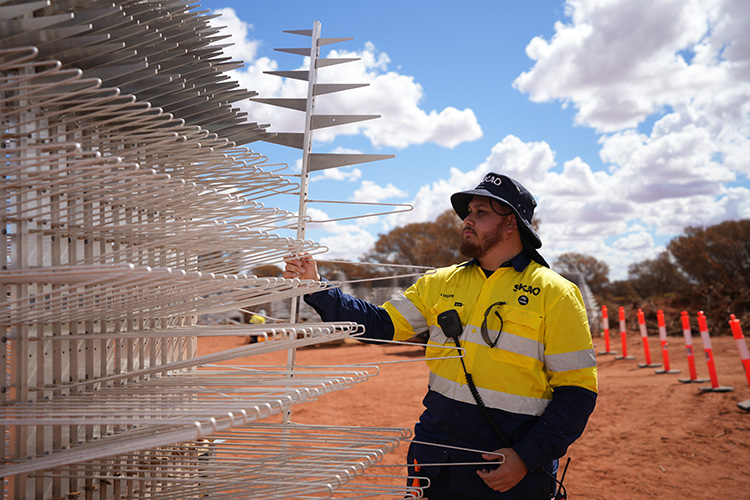Key points
- We are helping build the SKA-Low telescope at Inyarrimanha Ilgari Bundara, our Murchison Radio-astronomy Observatory on Wajarri Yamaji Country in Western Australia.
- SKA-Low is one of the two telescopes being built by the SKA Observatory (SKAO) that will revolutionise our understanding of the Universe.
- Our expertise has been instrumental in the development of the SKA telescopes, and the SKAO is now partnering with us in Australia to build and operate the SKA-Low telescope.
The international SKA Observatory (SKAO)’s ambitious science goals require some serious infrastructure. Which is why the SKAO is building the world’s two biggest radio telescopes – SKA-Mid in South Africa, and SKA-Low here in Australia.
When attempting something this big and remote, it’s good to have Australian expertise on hand.

Dr Douglas Bock is our Director of Space and Astronomy and the lead Australian scientific representative to the SKAO. He sees the SKA telescopes as an exciting leap forward.
“The SKA era is going to be incredible for radio astronomy. These telescopes will allow astronomers to study the Universe like never before. We'll gain insights into its earliest stages when the first stars and galaxies were forming,” Douglas said.
“The astronomy community has been talking about building telescopes like SKA-Low and SKA-Mid since the 90’s. We’re now seeing the two telescopes become reality.”
Hosting the SKA-Low telescope is bringing benefits into Australia. This will include investment in local industry and contracts for local businesses, as well as jobs within the telescope team that will operate and maintain it over its 50-year lifespan.
So, how are we helping make the SKA telescopes real?
Solving great challenges with Australian innovation
Australians have been leaders in radio astronomy since the beginning. Exploring the radio Universe was pioneered here at CSIRO by Dr Joseph Lade Pawsey and Ruby Payne-Scott. It has since exploded into a global field.
Some of the world’s best radio telescopes are here in Australia, including our ASKAP radio telescope and Murriyang, our Parkes radio telescope.
We brought this long experience of developing new technology and building and managing radio observatories in remote locations to the SKA design table. We took a significant role in planning infrastructure, telescope operations, software, and computing for the SKA telescopes.
We also helped secure Australia’s role as a host country for the SKA-Low telescope. We worked together with the Wajarri Yamaji People, Traditional Owners and Native Title Holders of the observatory site, and the Australian and Western Australian governments.
Our outback WA observatory
When you’re searching for a location to build the world’s largest radio telescopes, you need the best places on Earth to look out into the Universe.
Wajarri Country, in Western Australia, was identified as a front runner early in the search for an Australian site for the SKA telescopes. It had clear advantages such as a low population density and very low level of human-generated radio signals.
That search led to the creation of Inyarrimanha Ilgari Bundara, our Murchison Radio-astronomy Observatory. This was done in partnership with the Wajarri Yamaji and with the support of the Australian and Western Australian governments.
The observatory is now the location of two SKA precursor telescopes: our ASKAP radio telescope and Curtin University’s Murchison Widefield Array. This world class site is also home to Arizona State University's EDGES instrument.
On-site construction of the SKA-Low telescope began in December 2022.
In our role as observatory managers, we mitigate radio emissions from technology (including the radio telescopes themselves). This helps ensure the site remains one of the best places on Earth for radio astronomy.
We also take care of the observatory land. We work alongside Traditional Owners on regeneration and landcare and coordinate with our neighbouring pastoral stations.
Sharing sky and stars with the Wajarri Yamaji
The Wajarri Yamaji have been observing the sky from the observatory site for tens of thousands of years. Now, they’re sharing their sky and stars with us.
Our first Indigenous Land Use Agreement (ILUA) with the Wajarri Yamaji was finalised in 2009. That marked the official establishment of the observatory and kicked off the construction of our ASKAP radio telescope.
A new ILUA was finalised in 2022, enabling the on-site SKA-Low telescope construction to start. The new agreement expanded the observatory and included a Wajarri name for the site – Inyarrimanha Ilgari Bundara, which means ‘sharing the sky and stars’.
As part of our commitment to ensuring the protection of Wajarri heritage at the observatory we’ve walked Country shoulder-to-shoulder with the Wajarri People. Together, Wajarri, CSIRO and the SKAO developed a layout for the SKA-Low telescope. It ensures places of significance and the antennas can co-exist.
There are many intergenerational benefits to the local community that come from hosting the observatory. These include training and education opportunities as well as jobs on Country. Wajarri culture, including art and language, is being shared to the world through their partnership in the observatory and SKA project.
Telescope teamwork with the SKA Observatory
The SKAO is partnering with us in Australia to build and operate the SKA-Low telescope. This means that most of the SKA-Low team in Australia are also part of our CSIRO team.
The SKA-Low team has been working hard since on-site construction began on 5 December 2022. Construction work first focused on preparing infrastructure and laying power cables and optical fibre ready for installation of the antennas on site.
In March 2024 the first of more than 130,000 antennas were installed at the observatory for the SKA-Low telescope. This marked a major milestone on the path to the final telescope. Since then more than 2,000 antennas have been installed on site, alongside more infrastructure construction. This includes laying further power cabling and optical fibre, adding more of the mesh the antennas sit on, and constructing the buildings that will hold the computers needed to combine the signals from the antennas.
Despite still being under construction, the SKA-Low telescope is getting ready for its ground-breaking science. The SKA-Low team celebrated the first data from a completed station in August 2024. Then, the first ‘fringes’ between two completed stations were achieved soon after in September 2024, an exciting step towards detailed images of the sky.
The first image from an early working version of the SKA Observatory’s SKA-Low telescope, which is currently under construction on Wajarri Yamaji Country in Western Australia. It was produced using data collected from the first four connected SKA-Low stations, which together comprise 1,024 of the eventual 131,072 antennas of SKA-Low, spread over a distance of just under 6 km. The image shows around 85 galaxies in an area of the sky of about 25 square degrees – approximately equivalent to 100 full Moons. For comparison, it would be roughly the area of sky that a small apple would cover if you held it at arm’s length. The dots in the image look like stars but are in fact some of the brightest galaxies in the Universe, seen in radio light. These galaxies are billions of light years away and each contains a supermassive black hole. Gas orbiting around black holes is very hot and moves quickly, emitting energy in X-rays and radio waves. SKA-Low can detect these radio waves that have travelled billions of light years across the Universe to reach Earth. At the centre of the image is one of only a handful of galaxies known to expel jets of matter that are visible in both optical and radio light. When complete, the SKA-Low telescope will be sensitive enough to reveal up to 600,000 galaxies in the same region of sky. The SKAO recognises and acknowledges the Indigenous peoples and cultures that have traditionally lived on the lands on which our facilities are located. The data were obtained at Inyarrimanha Ilgari Bundara, the CSIRO Murchison Radio-astronomy Observatory. The SKAO and CSIRO acknowledge the Wajarri Yamaji as the Traditional Owners and Native Title Holders of the observatory site. Credit: SKAO. Additional image information The image was produced on a server located in the Pawsey Supercomputing Research Centre in Perth. Details of the image were confirmed by comparing the data with reference observations of the same area done with the Murchison Widefield Array, an SKA precursor telescope located near SKA-Low. The imaged area spans about 5 x 5 degrees centred on the bright galaxy PKS 0521-36, with a known integrated flux density at this frequency of ~56 Jy. The observations were made with a bandwidth of 25 MHz from 150-175 MHz with an integration time of 7 hours, station field of view of ~3 degrees full width at half maximum and image noise of 5-6 mJy per beam. The native resolution of the observations is ~66” x 36” with a final resolution of 70” for presentation.
The first test image from four SKA-Low stations showed nearby galaxies in an area the size of 100 full Moons. More than 600,000 more galaxies are expected to eventually be revealed in that same patch of sky with the full telescope.

Further together
We’re not just working with the SKAO to build and operate the SKA-Low telescope. We’re also collaborating with the SKAO alongside industry and research organisations across other areas of the complex SKA project.
We’re working with local expertise to manage the site infrastructure construction contracts on behalf of the SKAO. We are also helping the SKAO manage the important role of connecting all the individual telescope systems and checking they’re working together correctly.
Plus, we’re joining forces with international research institutions and university partners to develop the ‘brain’ of the SKA-Low telescope. It will combine the data signals received from groups of antennas.
We’re also part of the team developing the supercomputer software that will take that data and create the images astronomers will use to study the Universe.
The off-site computers for the SKA-Low telescope will be hosted by the Pawsey Supercomputing Research Centre. And we’re a foundation partner in the Australian SKA Regional Centre, the data conduit between the SKA Observatory and the astronomy community.
It’s an exciting time for Douglas, who’s been working on the SKA project for three decades.
“I’m proud of the leading role we’ve played in the SKA project so far, and it’s really only just the beginning,” Douglas said.
“Building a next-generation telescope is an exciting process to live through, one that takes years, sometimes decades, to fully realise.”
“I can’t wait to see the impact to astronomy from this leap forward in technology as well as the broader benefits of the SKA project.”
We acknowledge the Wajarri Yamaji as Traditional Owners and Native Title Holders of Inyarrimanha Ilgari Bundara, the CSIRO Murchison Radio-astronomy Observatory site.
